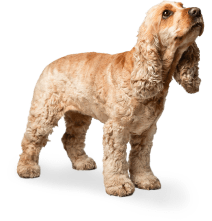

Dog moulting: why and when do dogs moult?
If you live with a dog, you’ll know that moulting is part of the deal. Fur on your clothes, your sofa – sometimes even in places your dog hasn’t been! But is dog moulting inevitable? What’s actually happening when dogs shed their coats? And how can you stop a dog moulting, or at least manage it? Let’s take a closer look.
What is dog moulting?
Dog moulting is a natural part of life, especially for dogs with thicker coats. But why do dogs moult? In the wild, seasonal shedding helps animals stay comfortable – losing an insulating undercoat in warmer months and growing it back when temperatures drop.
Dog moulting season – when?
For many dogs, moulting season happens twice a year:
- Spring – A lighter coat replaces the thick winter fur
- Autumn – A thicker coat grows in to prepare for colder weather
However, shedding isn’t always limited to these seasons. Many dogs shed all year round, just in smaller amounts.
Why is my dog moulting all year round then?
In the wild, shedding is triggered by changes in daylight and temperature. But for domesticated dogs living in centrally heated homes with artificial lighting, those signals can get a little mixed up.
Indoors, warmth and light encourage their body to shed, while the cold outside tells them to grow more coat. The result? A moulting cycle that doesn’t always follow the seasons.

How does dog hair grow?
At any given time, each hair on your dog’s coat is in one of four phases:
1. Anagen (growth phase) – The hair grows continuously.
2. Catagen (resting phase) – Hair growth slows and the hair may become detached from the follicle. Loose hairs often come out during brushing or when your dog rubs against furniture.
3. Telogen (shedding phase) – The hair falls out to make way for new growth.
4. Return to Anagen – The cycle restarts, with fresh hair beginning to grow.
This natural cycle is why dogs shed hair throughout the year, even outside of moulting season for dogs.
What else affects a dog’s moulting cycle?
Beyond seasonal changes, several factors play a role in dog moulting:
- Hormones – Pregnancy or heat cycles can affect coat shedding
- Diet – Key nutrients, like Omega-3 & 6, help support skin and coat health.
- Stress & environment – Moving home, changes in routine or new pets can have an impact.
- Breed – Some dog breeds don’t moult much, while others shed constantly.
While no breed is completely shed-free, some dogs shed far less than others. Dogs that don’t moult much tend to have hair rather than fur, meaning their shedding is minimal. Poodles, Bichon Frises and Schnauzers are good examples.
By contrast, double-coated breeds – such as Labradors, Border Collies and German Shepherds – shed more due to their thick undercoat, which insulates them year-round.
What’s ‘normal’ and what’s unusual dog moulting?
Moulting varies between dogs. Some shed lightly all year, while others have heavier seasonal moults. If you notice bald patches, irritated skin, excessive licking or changes from the ordinary, it’s best to check with your vet to rule out any underlying concerns.
Nutrition and dog moulting
Your dog’s skin and coat condition can be linked to their diet – and specifically the levels of Omega-3 and Omega-6 oils they’re getting. These essential fatty acids help keep skin soft, supple and healthy, which is important as each hair follicle (and the hair it produces) is part of the skin.
If your dog is prone to shedding or you simply want to support their coat condition, a targeted dog coat supplement can be a helpful addition to their routine. Even with a balanced diet, dogs may benefit from extra support in the form of high-quality oils or dog vitamins.
YuMOVE Skin & Coat Care Moulting for Dogs is a unique blend of premium oils that supports dogs with excessive moulting and fur loss. It combines Borage and Golden Flaxseed oils, delivering Alpha-Linolenic Acid (ALA) and Linoleic Acid (LA), along with Vitamin E to help reduce excess moulting and support healthy skin.
Dog moulting and bald patches
Sometimes, a heavy moult can leave bald patches or areas where the coat looks thinner. If this sounds familiar, it may be worth considering a supplement to support healthy hair and nail growth, as well as a trip to the vet to rule out anything more serious.
YuMOVE Skin & Coat Care Boost is a specially crafted nutritional powder that helps maintain skin health and supports strong hair and nail growth. It’s formulated with ingredients such as Biotin, Zinc, and antioxidant Vitamins C & E – a useful combination to help promote strength and growth.
How do I stop my dog moulting?
You can’t stop dog moulting, but you can manage it:
- Brush regularly – Removes loose hair before it ends up everywhere.
- Use grooming tools – De-shedding combs and rubber brushes can help.
- Support skin and coat health – Omega-3 & 6 oils can help maintain coat condition.
- Vacuum wisely – A pet-specific vacuum or grooming attachment can help manage shedding.
- Keep them warm outdoors – Some owners find that reducing cold exposure helps limit heavy undercoat growth.
While shedding is natural, good coat care can help keep it under control – and your home a little less furry.
Final thoughts on dog moulting
Moulting is part of life with a dog, but a healthy coat starts from within. With the right grooming routine and nutritional support, you can help keep their coat in good condition – and your floors a little less hairy.
Got any top tips for managing dog moulting? Share them with us on Facebook or Instagram – we’d love to hear how you handle shedding season.




